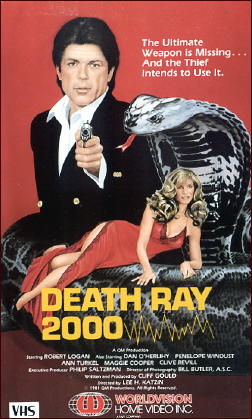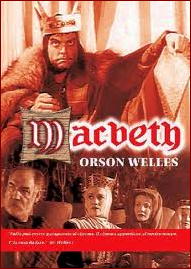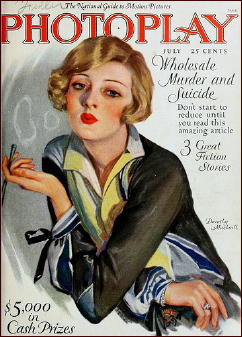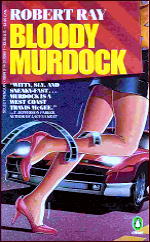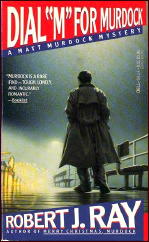December 2011
Monthly Archive
Thu 29 Dec 2011
THE BACKWARD REVIEWER
William F. Deeck
ELIZABETH CURTISS – Nine Doctors and a Madman. Simon and Schuster, hardcover, 1937.
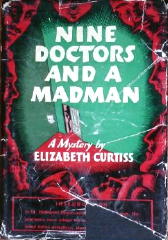
The subgenre of mysteries dealing with insane asylums seems to be few in number but high in quality. Now Curtiss’s novel can be added to the list, and it is a fine addition.
One of the nine doctors at Brandmere Hospital is murdered by an inmate, or so it would appear. The inmate says he did it, is in a room alone with the corpse, and has the bloody skewer; the other physical evidence, however, contradicts his claim.
Nonetheless, he must have done it since no one else in the hospital seems to have had the opportunity, though most of them had a motive. A simple mind, my mind, but I would judge that there’s tricky fair play here.
Curtiss writes and observes well: “Her hair had been meticulously pinched and plastered into waves which would have turned a Greek sculptor green with envy.”
Her detective, Nathaniel Bunce, M.D., whom the publisher describes as a psychologist but must be a psychiatrist, is a character who might have achieved greatness if he had appeared in more than two novels, assuming the second matches the quality of this one. [The second being Dead Dogs Bite (Simon & Schuster, 1937).]
Describing the narrator of the novel, young and naive Dr. Theophilus Bishop, Bunce says: “Your mind … is like a kangaroo. It jumps, high, wide and handsome. It leaves, therefore, vast areas untrodden.”
ADDENDUM:
For those who may be interested, the novels that I have read that have as a setting mental institutions or have reason to believe deal with that sort of establishment are:
Murder in the Madhouse, by Jonathan Latimer
The Deadly Chase, by Carter Cullen
Shock Treatment, by Winfred van Atta
Night World, by Robert Bloch
The Drowning Pool, by Ross Macdonald
The Goodbye Look, by Ross Macdonald
No Face in the Mirror, by Richard Copeland in the UK, Hugh McLeave in the US
Death in the Doll’s House, by Hannah Lees and Lawrence Blochman
Crazy to Kill, by Ann Cardwell
The Odor of Bitter Almonds, by James G. Edwards
A Mind to Murder, by P. D. James
The Spectacles of Mr. Caligostro, by Harry Stephen Keeler
Snow White and Rose Red, by Ed McBain
A Puzzle for Fools, by Patrick Quentin
Shadow of a Doubt, by June Thomson.
— From The MYSTERY FANcier, Vol. 12, No. 4, Fall 1990.
Wed 28 Dec 2011
A TV Review by Michael Shonk.
DEATH RAY 2000. NBC-TV Movie; aired 05 March 1981. (aka T. R. Sloane) Pilot for NBC-TV series A Man Called Sloane (1979-1980). QM Production/Woodruff Production. CAST: Robert Logan as Thomas R. Sloane, Dan O’Herlihy as The Director, Ann Turkel as Sabina, Maggie Cooper as Chrissy, Clive Revill as Erik Clawson, Ji-Tu Cumbuka as Torque, Michele Carey (voice) as Effie. Written and produced by Cliff Gould. Executive Producer: Philip Saltzman. Director: Lee H. Katzin.
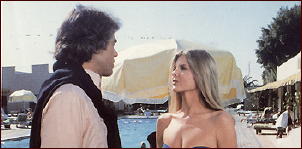
A gang of nuns walk into Gideon Peak Observatory where a scientist is testing a new top-secret “weather machine,†a device that can control the weather by removing all moisture from the atmosphere. The lone security guard informs them closing is in five minutes. The nuns, with the aid of Torque, a seven foot giant with a metal hand, dismantle the giant ray gun and take the large pieces out the backdoor to their van.
Torque is most helpful when he substitutes a screwdriver for his index finger to remove some stubborn screws. The screws put up a better fight than the humans did, since security was virtually non-existent. When the scientist interrupts the heist, one of the nuns kills him with deadly thimble like devices on two of her fingers. The nuns and Torque with his Swiss army hand escape with the device.
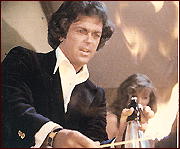
OK, I am hooked all ready. But this classic continues to produce more cheese than Wisconsin. Seems the ray gun is so powerful it can drain water for miles, through any object including mountains, and it can dehydrate people into nothing but bones and cute hair.
Naturally the government is upset that someone has stolen a top-secret weapon that could destroy the world, a weapon they had left in a public building with only one friendly guard as security. They come to UNIT looking for help and begging for our hero Thomas R. Sloane.
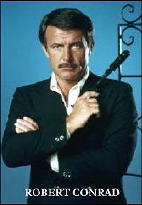
UNIT is a top-secret agency located in the farmlands of Kentucky where The Director works out of his house. This being a spy movie the house is of course not your typical home. It contains a six-ton computer named Effie, complete with a sexy female voice. And as all females in this story, Effie has fallen for the only man who can save the world, Thomas R. Sloane the 3rd.
Sloane, following in the famous footsteps of his father, is a top secret agent and owner of Sloane & Sons, a successful art and antiquity business. We first meet the great spy as he successfully completes his mission in Cuba. He escapes the soldiers by rocketing an elevator through the roof and into the air where a waiting helicopter catches it.
Robert Logan (77 Sunset Strip, The Adventures of the Wilderness Family) gives Sloane all the passion of someone wanting to take a nap. The rest of the cast is more animated, adding ham to all this cheese.
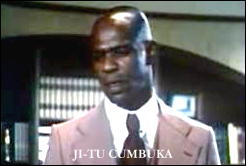
The story travels the usual path, Sloane drives a great car, the evil mastermind has his pets (this time he cuddles with snakes and a spider), recurring fight scenes, sex interrupted or off stage (this is 70s TV), Rube Goldberg death traps, an evil organization named Kartel (“with a Kâ€), and the villain meeting his end at his own hands.
My favorite moment is when writer Cliff Gould (Mod Squad, Streets of San Francisco) makes his motives clear and uses cheese as a vital clue. Ian Fleming should be so clever.
The most shocking twist didn’t come from the story, but the production credits for this cheese fest that would have made Aaron Spelling giggle. This was from Quinn Martin! The QM Productions of The Fugitive, The FBI, Cannon, etc.
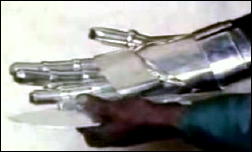
It was the final QM series to debut on television (Barnaby Jones would be the last on the air). There is no better example of how television changed during the seventies than compare Quinn Martin’s first series of 70s, Dan August (1970) to Quinn Martin’s last, A Man Called Sloane (1979).
The movie was released on VHS but not on DVD. It can also be seen on YouTube in ten parts, starting here.
There were changes made when this pilot lead to the series, A Man Called Sloane. Most notable was Robert Conrad replacing Robert Logan as Sloane and Torque the Swiss army hand bad guy becoming Sloane’s good guy sidekick.
Tue 27 Dec 2011
REVIEWED BY DAN STUMPF:
MACBETH. Republic Pictures, 1948. Orson Welles, Jeanette Nolan, Dan O’Herlihy, Roddy McDowall, Edgar Barrier, Peggy Webber. Adapted by Orson Welles (uncredited) from the play by William Shakespeare. Director: Orson Welles.
On most occasions I need only the flimsiest of excuses to speak of Welles’ 1948 film of Macbeth, which he did for peanuts on the back lots at Republic Studios.

Like most of his films, it was badly mauled before release, including completely new dubbing and the excision of about 20 minutes running time. It is now, however, restored and available on videotape, and you should run out and get it.
Someone — me, I think — once said that every hardboiled novel and film noir owes a debt to Shakespeare. Welles seems to have sensed this, turning Macbeth into a very noirish-looking film indeed, with lots of shadows and heavy fog to hide the cheap sets, vaguely menacing blackmailers and detective-types, and a Lady Macbeth (Jeanette Nolan) straight out of James M. Cain.
Edgar Barrier, normally a rather inexpressive actor, offers a fascinating interpretation of Banquo as co-conspirator, and Dan O’Herlihy makes a tough MacDuff. Welles naturally has a lot of fun with himself as Macbeth, lurching about drunk most of the time, and he has the whole cast speak in beautifully thick Scottish Brogue, so that “Sleep no more, Macbeth has murdered Sleep” comes out: “Slyeep nae Mairlrlrl, MaycBayth hae Mairlrlrlredairlrlrlred Slyeep!”
A bit hard to follow in the denser passages, but fun to listen to.
— Reprinted from A Shropshire Sleuth #52, March 1992.
Tue 27 Dec 2011
Posted by Steve under
Reviews[5] Comments
REVIEWED BY RAY O’LEARY:
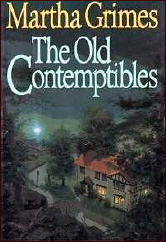
MARTHA GRIMES – The Old Contemptibles. Little Brown, hardcover, 1991. Paperback reprints include: Ballantine, 1992; Onyx, 2006.
Superintendent Richard Jury is at an antiques flea market when he meets Jane Holdsworth, a widow with a sixteen-year-old son. They begin an affair so intense that Jury is about to propose marriage when she suddenly dies of a barbiturate overdose.
Though it looks like suicide, there’s enough wrong with the circumstances surrounding her death for Jury to be suspended while the death is under investigation.
This brings Jury’s friend Melrose Plant onto the scene, where he gets a job with the dead woman’s estranged in-laws to find out what he can. What he discovers is that not only did Jane’s late husband also commit suicide, but also both his mother and the family Cook were killed in supposedly accidental falls.
Grimes excels here in the creation of characters, and she gives herself plenty of range in which to strut her stuff: besides the usual characters, there are two children, the dead cook, and a couple of senior citizens, one of them a kleptomaniac. With a cast like that, how can it miss?
Mon 26 Dec 2011
Posted by Steve under
General[19] Comments

…and We’re Having a Party!
THE NUMBERS: 3082 Posts
in 48 Categories
680,390 visitors
with 1,167,268 pages viewed
and 12,587 comments left
not including 1,773,557 spam messages deleted.
Thanks, everyone! As I’ve said before, whenever occasions like this have come along, I couldn’t have done it without you!
Thu 22 Dec 2011
Posted by Steve under
General[6] Comments
I’ll be taking a few days off from the blog — an extended weekend, you might say, beginning today. The end of December is always a busy time of the year, and this year is no exception. I’ll be back on Monday or Tuesday, and even then the blog is likely to remain in low maintenance mode until the New Year comes around.
My most sincere best wishes to you and your families: Merry Christmas, Happy Hanukkah, Cheers All Around!
Wed 21 Dec 2011
Posted by Steve under
Reviews[6] Comments
Reviewed by GLORIA MAXWELL:
PATRICIA HIGHSMITH – Little Tales of Misogyny. Otto Penzler, hardcover, April 1986. Norton, softcover, August 2002. [See also Comment #4.]
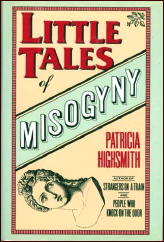
As the title indicates, this book is a collection of sharp, biting indictments of women. The author’s theme is the destructive quality women have over men — innocently wrought, or with knowing spite. This destructiveness is sometimes personally fatal to the woman as well.
Some stories are macabre, such as “The Hand,” wherein the prospective groom actually receives the hand of the woman he loves — after asking for it in marriage. Others are tongue in cheek fun: “Oona, the Jolly Cave Woman”:
“It was not necessary to club Oona to have her, but that was the custom…”
In some cases, the titles alone give an adequate preview for what is in store: “The Breeder,” “The Fully-Licensed Whore, or the Wife,” “The Prude,” “The Victim.” In all, seventeen tales of sparkling satire.
This book will not be for everyone, and readers who tend to be squeamish or easily shocked are hereby warned to beware. However, for those brave enough, or daring enough, to pick up this jewel, a definite reading treat is in store. Highsmith is truly a master of her storytelling craft and bold enough to tell it like it really is — in a unique, pulsating manner.
— Reprinted from
The Poisoned Pen, Vol. 7, No. 1, Fall-Winter 1987.
Wed 21 Dec 2011
REVIEWED BY WALTER ALBERT:
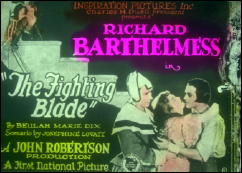
THE FIGHTING BLADE. Inspiration-First National, 1923. Richard Barthelmess, Dorothy Mackaill, Lee Baker, Morgan Wallace, Bradley Barker, Frederick Burton, Stuart Sage, Phil Tead, Walter Horton. Story: Beulah Marie Dix; scenario: Josephine Lovett; art director: Everett Shinn. Director: John S. Robertson. Shown at Cinecon 39, Hollywood CA, Aug-Sept 2003.
Barthelmess plays Karl Van Kerstenbroock, a Flemish soldier of fortune who joins Cromwell’s forces. Going undercover, he visits the home of the fiancé of Thomsine Mugrove (Mackaill) whose cowardly brother (Bradley Barker) had earlier fled a duel with Van Kerstenbroock. Musgrove risks her life to help Von Kerstenbroock and is rescued by him after he leads Cromwell’s forces to victory.
Barthelmess is a somewhat unlikely action hero, but character development and conflict are not neglected in this film, handsomely designed by noted contemporary illustrator Everett Shinn. Barthelmess is moody and often diffident in his acting style, a striking contrast to the flamboyance of an Errol Flynn or Douglas Fairbanks, Sr.
I liked the film, but Jim Goodrich found it lacking the brio he appreciates in a swashbuckler. (I hope that Jim won’t mind if I report that he referred to it, in passing, as a “swishbuckler.”)
Dorothy Mackaill:
Tue 20 Dec 2011
TV REVIEW AND HISTORY – THE FILES OF JEFFREY JONES
by Michael Shonk.
The Files of Jeffrey Jones. CBS Television Film Sales. Lindsley Parsons Productions. Syndicated, 1952. 39 episodes x 30 minutes. CAST: Don Haggerty as Jeffrey Jones, Tristran Coffin as Lt. Doyle, Gloria Henry as Michelle “Mike†Malone, Vince Barnett as Joe.
The following episode can be viewed at TV4u.com at this link. Scroll down and click on Files of Jeffrey Jones. Yes, that is a picture from Cases of Eddie Drake. Poor Jeff, when will people realize he is his own man?
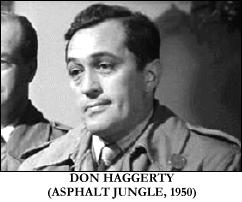
“Killer Bait.†Written by Robert Raynor and Warren Douglas. Directed by Lew Landers.
We open on a title card with a painting of a city at night. The episode title is featured larger and above “from the files of JEFFREY JONES.†The copyright is 1952. Playing over this is the worst theme music in television history.
PI Jeffrey Jones arrives at his “office,†a Hollywood bistro called The Golden Bubble. Jeff, who had been studying for a law school exam, learns from the bartender (Frank Sully) everyone wants him to drop his client, a client Jeff did not know he had.
There is a shipment of counterfeit one hundred dollar bills missing that is upsetting cops and mobsters alike. Jeff is beaten up by the bad guys, yelled at by Lt Doyle, and discovers two murder victims, all before he meets his “client,†who denies hiring Jeff.
The client is framed for one of the murders. Jeff stays one step ahead of the cops as he eliminates suspect after suspect until he finds the killer in time for the final shoot out.
You could see Haggerty was having fun with the smart aleck PI Jeffrey Jones. There were two femme fatales (played by two bad actresses), a couple of goons from Kansas City, an OK mystery driven by fistfights, and a script with a sense of humor.
When the cops find Jeff in a locked closet recovering from his latest beating, Doyle asks him what he is doing there. Jeff replies, “Playing hide and seek.â€
The production values were above average for the time. Short scenes helped speed the pace of the episode, but the scenes themselves were too static, with director Lew Landers holding too long on each shot.
If you are willing to forgive the limitation of the times, this is an entertaining TV PI show.
THE FILES OF JEFFREY JONES began shooting April 17, 1952 (Broadcasting, April 14,1952). While the exact date of when Jeffrey appeared on TV is still unknown, it was no later than June 7, 1952.
The series was a hit from almost the beginning. According to a CBS Television Film Sales ad in Broadcasting (February 23, 1953), in less than eight months on the air the series was in 25 markets and in Telepulse’s Top Five ratings for syndicated film shows.
The series took place in Hollywood (not New York as many claim today). The episode “Killer Bait†was missing two cast members, Michelle “Mike†Malone, a newspaper reporter played by Gloria Henry and Jeff’s friend Joe, played by Vince Barnett. Both actors were listed as cast members in the trades’ news reports and series’ ads (Billboard and Broadcast).
Those who remember my earlier reviews of The Cases of Eddie Drake (links below), watched the episode “Shoot The Works†(link below) and read the two shows’ credits, now know Jeffrey was not produced by the same people who did Cases of Eddie Drake as is believed today.
The series have only two things in common, star Don Haggerty and CBS Television Film Sales. So why do so many reference books and sites have this wrong?
According to Broadcasting (February 25, 1952 and April 14, 1952), CBS TV Film Sales sold both series to sponsor Crawford Clothes Inc (via Al Paul Lefton Co. New York) to air on DuMont’s New York station WABD.
Eddie Drake would start March 6, 1952 and run its 13 episodes. Once Eddie was done, Jeffrey Jones took over the time slot (on June 7, 1952). Jeffrey was originally scheduled to do 26 episodes but at some point expanded to 39. The two series would continue to be linked as CBS sometimes sold them together as a package to stations (Billboard, May 21, 1955).
Sadly, Files of Jeffrey Jones and Cases of Eddie Drake will always be connected because both starred one of television’s first original stars.
In an article in Broadcasting (September 13, 1954) about residuals and early television, “But TV has created its own stars, as Mr. Haggerty can testify. In 1948, shortly after he appeared in the live NBC-TV Mr. and Mrs. North, first play televised in New York, he was starred in CBS-TV Cases of Eddie Drake, second TV series filmed. However, both Eddie Drake and the first 26 segments of Jeffrey Jones were filmed prior to the SAG agreement date and as one of TV’s newest stars, Mr. Haggerty was unable to negotiate any residual deal himself.â€
The same article had Haggerty explain why so many series stars agreed to promote the sponsor’s product during the show’s commercial break, “the star makes more money from the commercials than from the program.â€
The Files of Jeffrey Jones was still available from CBS for syndication in 1963 (Broadcasting, March 25, 1963). Why isn’t this series on DVD?
OF ADDITIONAL INTEREST:
Earlier reviews of The Cases of Eddie Drake:
https://mysteryfile.com/blog/?p=10405
https://mysteryfile.com/blog/?p=10427
https://mysteryfile.com/blog/?p=12204
The Eddie Drake episode “Shoot The Works†can be seen here.
Sun 18 Dec 2011
THE ARMCHAIR REVIEWER
Allen J. Hubin
ROBERT J. RAY – Merry Christmas, Murdock. Delacorte, hardcover, 1989. Dell, paperback, 1990.
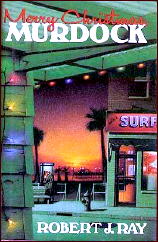
L.A. private eye Matt Murdock is back, celebrating a holiday in decidedly unfestive fashion in Merry Christmas, Murdock, by Robert Ray.
Here the past rises up before Murdock in two ways. Cindy Duke, a teen-ager who had maybe saved his life a couple of years earlier by driving him out of a burning canyon, asks him to find her father. He teaches in Wisconsin and came to L.A. in response to Cindy’s cry for help, raged at his ex-wife, battered her brother’s car with a baseball bat, ranged through a shopping mall in a failing search for Cindy, and disappeared.
Meanwhile, another teenager, Heather Blasingame, lies in a coma from a hit-and-run encounter with a vehicle at that same mall. She’s the daughter of Jane Blasingame, feisty Texas state senator, and the senator (though with considerable reluctance) hires Murdock to supplement what seems an inept police investigation.
These two cases are of course related, and powerful interests — not only Cindy’s grandfather Wheeler Duke and Duke Construction — are willing to go to about any lengths to keep Matt’s nose out of these matters.
Vivid, active tale.
— Reprinted from The MYSTERY FANcier,
Vol. 12, No. 4, Fall 1990.
The Matt Murdock series —
Bloody Murdock. St.Martin’s, 1986.
Murdock for Hire. St.Martin’s, 1987.
Dial “M†for Murdock. St.Martin’s, 1988.
Merry Christmas, Murdock. Delacorte, 1989.
Murdock Cracks Ice. Delacorte, 1992.
Next Page »






